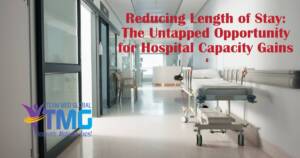 In today’s healthcare environment, hospitals are under constant pressure to improve efficiency, manage capacity, and deliver quality care. One metric that touches all these goals is length of stay (LOS)—a key indicator of both patient flow and system performance. While LOS reduction is often addressed through clinical protocols and discharge planning, an untapped opportunity lies in credentialing and provider readiness. Provider Lifecycle Professionals (PLPs), through their work in licensing, credentialing, and provider enrollment, can influence LOS in ways that are often overlooked—but no less impactful.
In today’s healthcare environment, hospitals are under constant pressure to improve efficiency, manage capacity, and deliver quality care. One metric that touches all these goals is length of stay (LOS)—a key indicator of both patient flow and system performance. While LOS reduction is often addressed through clinical protocols and discharge planning, an untapped opportunity lies in credentialing and provider readiness. Provider Lifecycle Professionals (PLPs), through their work in licensing, credentialing, and provider enrollment, can influence LOS in ways that are often overlooked—but no less impactful.
The Hidden Connection Between Readiness and Capacity
When a hospital needs to onboard a new provider, every day of delay affects staffing coverage, patient care continuity, and ultimately LOS. Without the necessary providers in place—whether hospitalists, specialists, or surgeons—patients may wait longer for consults, procedures, or discharge approvals. These delays can extend length of stay and reduce the number of patients the hospital can serve. PLPs ensure providers are credentialed, enrolled, and ready to practice without unnecessary lag, making them key players in the hospital’s capacity strategy.
Credentialing Bottlenecks Create System Strain
A backlog in credentialing doesn’t just affect the provider—it affects the entire care team. Nurses, case managers, and discharge planners rely on timely physician input to move patients through the care continuum. If a provider isn’t ready to practice due to credentialing or enrollment delays, it can create gaps in coverage that lead to postponed decisions and avoidable inpatient days. PLPs who proactively manage credentialing timelines help avoid these bottlenecks and maintain patient flow.
Enrollment Delays = Revenue Delays
Even when credentialing is complete, payer enrollment delays can limit a provider’s ability to bill for services, discouraging full engagement. Some hospitals restrict providers from seeing patients until enrollment is finalized, further straining resources. PLPs who coordinate enrollment with credentialing ensure maximum provider productivity from day one, supporting both operational efficiency and financial health—key drivers of hospital capacity.
Data-Driven Readiness
PLPs who track and report on onboarding timelines, average credentialing days, and enrollment processing times can help leadership identify systemic delays and prioritize solutions. Sharing this data across departments can drive process improvements that enhance provider readiness, reduce LOS, and support broader hospital efficiency goals.
From Back Office to Frontline Impact
Reducing length of stay isn’t just a clinical goal—it’s a cross-functional effort that demands both clinical coordination and administrative excellence. PLPs, through precise credentialing and enrollment processes, ensure providers are ready to deliver care without delay, supporting timely patient assessments, coordinated discharges, and optimal patient flow. In the drive to maximize hospital capacity and enhance quality metrics, provider readiness is a lever hospitals can’t afford to overlook—and PLPs are the professionals who make it possible.

